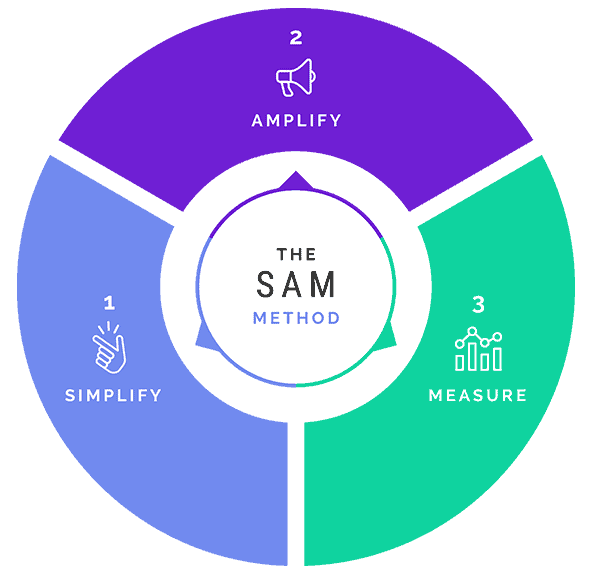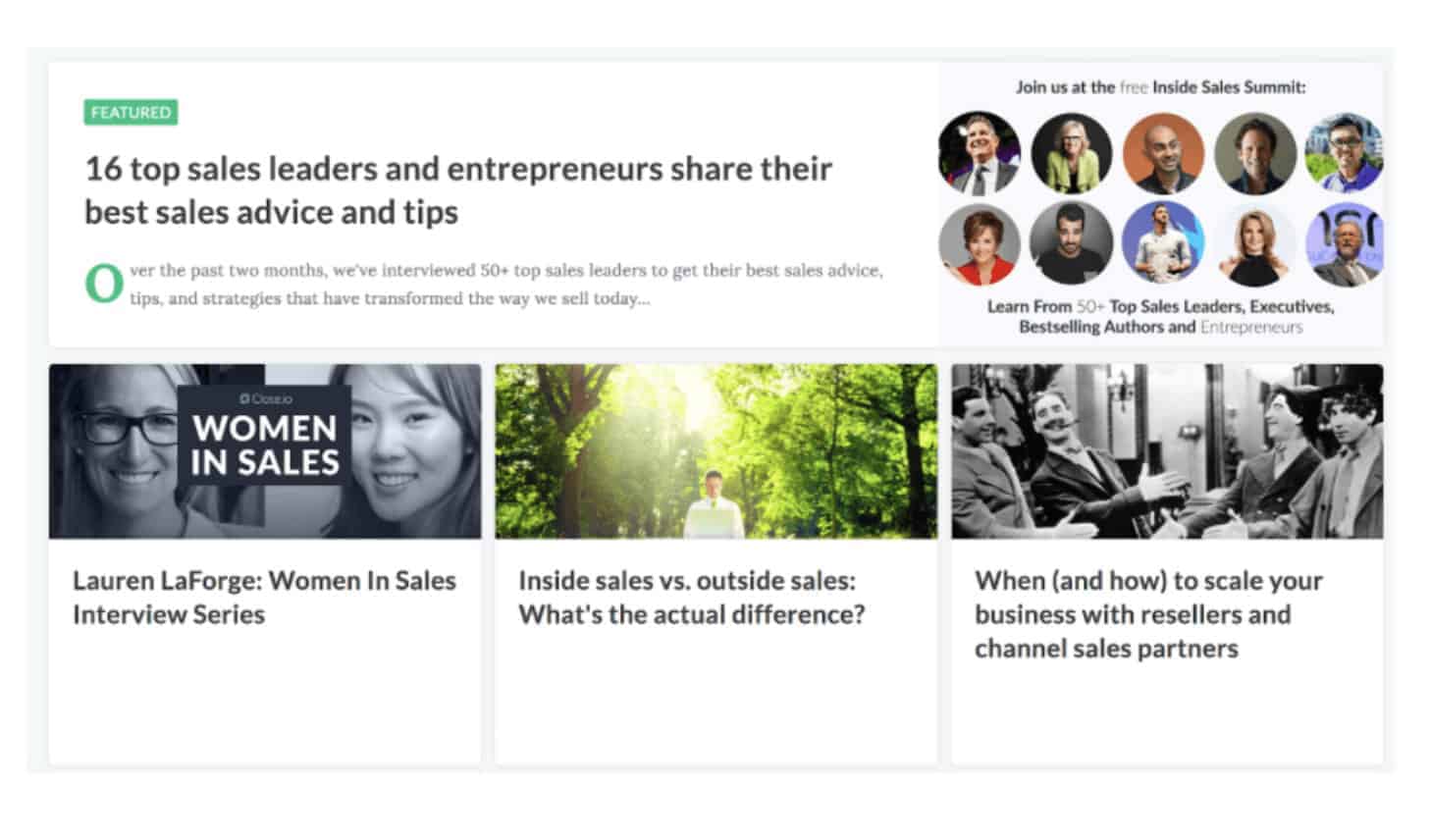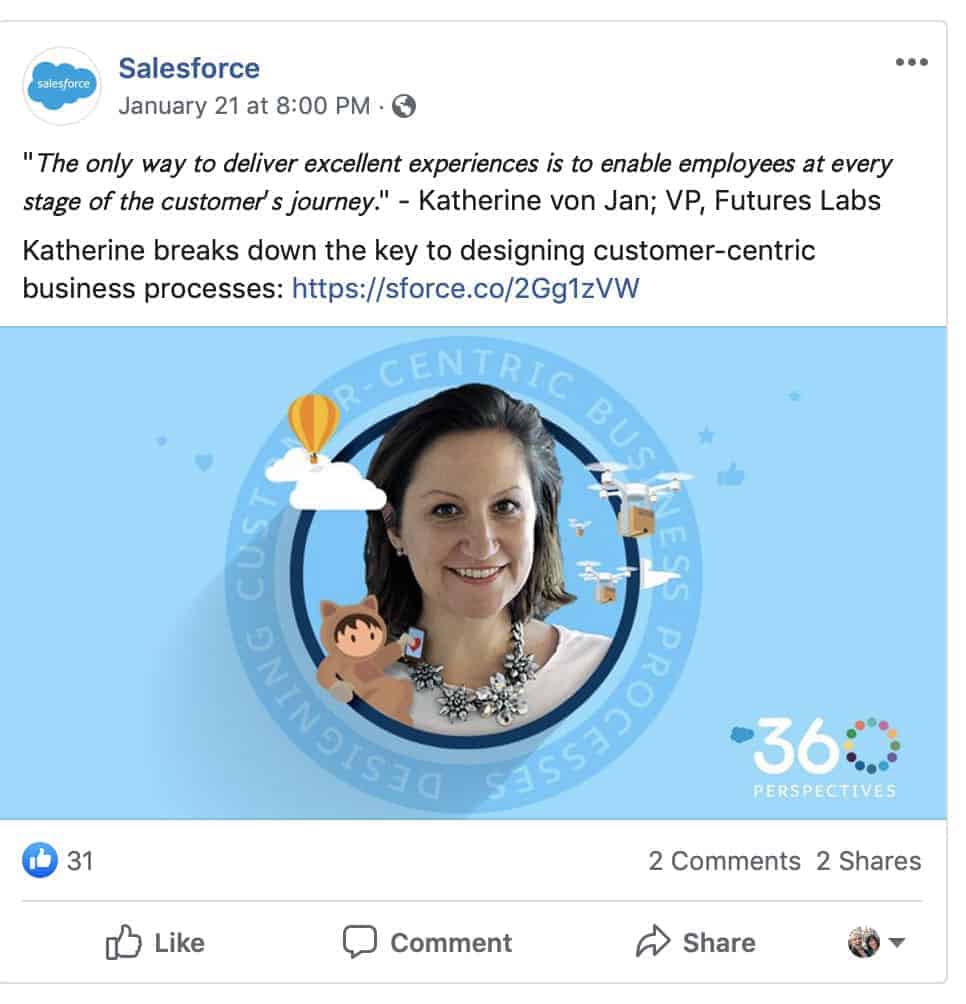If you’ve spent much time in the b2b world recently, you’ll have noticed something.
The best B2B marketing—the kind that holds your attention and makes you actually want to engage with a brand—looks more and more like it could belong to a b2c brand.
The user experience is seamless. The information you need is accessible and easy to find. No one is trying to bait you into meeting with a salesperson.
That’s because today’s b2b buyers expect very different things from the brands they work with than those of a decade ago.
After all, the people who are setting up million-dollar contracts with vendors are the same people who are used to getting free 2-day delivery on their consumer goods and being able to compare prices for a single item across multiple websites.
So how can you appeal to this new b2b buyer, and create b2b marketing that converts into real sales? Let’s dive in.
Who is the b2b buyer?
Perhaps the most important thing to know about the b2b buyer today is that they are already 60 percent through the buying journey by the time they contact a brand, according to the most recent research by Gartner.
That means that if they’re reaching out to you, you don’t have time to course-correct. If you make a bad first impression after they’ve done 60 percent of their research into you, they’ll move on to the next brand faster than you can reply to an email.
B2b buyers share lots of the same characteristics with connected consumers (because in their off-the-clock lives, they are connected consumers).
As we found in our proprietary research into the phenomenon of the connected consumer, connected consumers are:
- Independent, yet interconnected
- Idealistic, yet discriminating
- Digitally native, yet highly hands-on
- Gods, yet all too human
While we won’t go into each of these paradoxes exhaustively here, here’s a general look at how these apply to the b2b buyer.
B2b buyers, like consumers, have access to a greater amount of information today than ever before—which means they are much less reliant on gatekeepers, like sales staff, when it comes to finding out what they want to know.
They independently seek out the information they want, but they often do it by connecting with their peers. In the b2c world, this is generally done through looking for reviews of a product or service on review sites; for b2b, this can be done through social listening, or by speaking with peers in their industry about their experiences with certain vendors.
Above all, the connected b2b buyer wants reassurance that they’ve made the right purchase decision, which means they’ll seek that out even after they’ve already sealed the deal.
This also has to do with the “gods, yet all too human” paradox—because buyers can access vast, often overwhelming amounts of information on their own, they can often be uncertain or hesitant buyers.
Another important fact about the b2b buyer? Up to 73 percent of them are Millennials, and they’re from a wide variety of departments, job descriptions, and geographies.
How to reach the b2b buyer today
There are lots of practical, strategic ways to reach the b2b buyer today, which we’ll get into—but first, it’s important to realize that for us at Zen Media, the backdrop for solving any and every business problem is business relations.
That’s because every business problem is, at its core, a relationship problem. If you’re not getting enough leads, you haven’t developed relationships with enough potential clients. If you’re losing clients, the relationships you have aren’t being nurtured properly.
If business relations is the backdrop for our problem-solving, then the SAM Method is how we solve problems.

SAM stands for:
Simplify
Amplify
Measure
By cutting through complexity to clearly, personally, and relevantly connect with their target audience at scale, b2b brands can build and secure brand equity and drive bottom-line results.
Here’s what that looks like in terms of marketing strategy.
B2B Content Marketing
B2B content marketing is all about giving your leads the right information at the right time.
This is even more important in b2b than in b2c, because of that statistic we mentioned earlier: the average buyer is already 60 percent of the way through the buying journey by the time they contact you.
And here’s another statistic for you: 63 percent of consumers think marketing wastes time trying to force prospects to pay attention instead of making them want to pay attention.
That means that you’ve got potential clients out there making the choice to purchase from you before you even know they exist. If they’re going to buy from you, you’ve got to make it easy for them to move through each step of the journey—and the way to do that is to make it easy for them to find the information they need.

Close.io software, from source Foundation Inc.
Begin by doing a deep dive into the questions that your clients generally ask and/or the pain points you know they experience. Is pricing one of the first things they request? Do they wonder about tech support options? Ramp-up time? What clients have said about you?
Once you’ve figured out which pain points or questions they’re asking, do a content audit to see where your content gaps are.
Some gaps can be filled by blog posts, while others may need a dedicated section or page on your website (pricing, for example). Still others may need more complex content, like a brief video walkthrough of your software, or a free report detailing your latest research.
The idea is to close first, and convince later.
B2B Social Media Marketing
Once upon a time, it made sense to “use” digital advertising. But that was before everybody “spoke social,” before the widespread adoption of the internet and before social media was the newest, bright shiny object in the digital universe. Back then, campaign lifecycles and consumers’ journeys could be clearly identified, neatly segmented, and accurately assessed. Back then, it made sense to “use” social media to reach consumers.
But in the context of the all-pervasive digitally-enabled connectivity that characterizes today’s connected consumer, marketers need to grasp the fact that the idea of “using” social media is obsolete.
This isn’t because consumers are less social, but because they’re becoming more social in terms of increased digital connectivity across multiple touchpoints and in their relationships with brands and fellow consumers.
This means that we’re seeing a widespread shift from a mindset of using social media to a mindset of adapting and thriving in an ecosystem where a highly connected, social, empowered consumer is now the non-negotiable norm.

Source: Salesforce’s Facebook page
In other words, marketers will no longer view social as a channel they can more or less successfully surf but as the online and offline water in which consumers and brands alike are inescapably swimming.
While b2c social media marketers have learned to speak to consumers in increasingly human, authentic ways, b2b has been slower to realize the value of this approach.
B2B social media marketing still has a tendency to speak to buyers in transactional terms or sales-talk that can feel impersonal and fail to inspire buyers’ trust.
Consumers have become increasingly interested in the actual human beings behind the public persona of businesses and brands. b2c has responded by giving consumers an inside perspective on the brand by telling compelling stories about those inside it (employees and stakeholders), or those personally impacted by it. These kinds of authentically told stories leave consumers less likely to feel they’re being pitched and more likely to feel they’re being treated like family.
This approach helps to humanize the brand and b2b is rapidly responding in kind. b2b is now taking to heart the reality that buyers resent feeling like the target of a marketing ploy just as much as consumers.
With this understanding, b2b will continue to become more human in its approach by dispensing with sales-speak and relying on compellingly told stories as the most valuable currency of authentic engagement.
Remember: Simplify. Amplify. Measure.
Simplify by losing the jargon and marketing-speak. Talk to your prospects like humans.
Amplify by engaging in social conversations around topics that are important and relevant to your clients, in which you can have a meaningful voice.
And measure through the right analytics: not just reach, but engagement. How many clients are coming to your site from social posts or social advertising? How often are you being tagged in social conversations pertaining to your industry?
B2B Email Marketing
According to Hubspot, 93 percent of b2b marketers use email marketing, and the reason? It works.
One of the best things about email marketing for b2b brands is that it’s an excellent way to share your content—you know, the content that your potential clients are already looking for on their own.
By pushing out content through email on a weekly, bi-weekly, or monthly basis, you’ll be making contact with more prospects more often, nurturing that relationship as you do so.
What’s more, by paying attention to data like click-through and open rates, you’ll be able to see what kinds of content are resonating the most with your prospects and clients. Then you can use that data to create more of that content, as well as improve the quality.
Another thing to remember is that while b2b buyers do want to be spoken to like people, without the marketing jargon, they still want answers to the question: How can you help my business?
Stories play an important role here just like they do in b2c marketing—however, b2b buyers also need facts, logic, and proof that you can do what you claim to. That may mean including a client testimonial in your B2B email marketing now and then, or sharing data on how you’ve helped past and current clients.
Automation
Small businesses, in particular, will need to take advantage of automation if they want to stay competitive. The key behind automation is that it’s designed to save businesses time and money. It’s also linked to consumer behavior such as filling out a form or adding something to their cart on your website. This means that an automated email is 70.5% more likely to be opened. It provides information to your customers exactly when they need it.
Mobile-Friendly
There’s a good chance that your audience is accessing their email on their smartphone. This means it’s important that the emails you send can be easily read on a mobile device.
When thinking about mobile viewing, keep your subject lines short, your content concise, and use clear calls to action and engaging preheader text.
Personalization
Mass impersonal email blasts just don’t work. Personalize emails by using your customers’ names when you have them. Emails that use people’s first names get higher open rates than those that simply say “Dear Customer.” It’s also a good idea to personalize the “from” portion of your email. It’s important to make sure it’s clear who the email is coming from. Emails sent from a personalized account are more likely to be opened than those that are sent from a “no reply” address.
Create thoughtful and personalized email subject lines that are relevant to your subscribers. It’s important that the subject line gives your readers an idea of what your email will be about and isn’t just something catchy to try and trick them into opening your email. Nobody likes to be tricked.
Interactivity
Increase engagement with your emails by including functionality in your emails.
Another way to increase interactivity and engagement is to send to lists that actually want to hear from you. Stop sending to lists with low open rates. Low open and engagement rates hurt your domain reputation and your chances of engaging with other customers who are interested in hearing from you. Don’t be afraid to remove subscribers who aren’t opening your emails.
You should also always have a goal for your email before you hit send. Think about what you want your subscribers to do, if anything, before drafting your email. Then write the entire email with that in mind.
Once you’ve done that, you have to make it easy for your subscribers to do what you want them to do. If you want them to read your blog post, put the link front and center.
Provide more than one way for your subscribers to achieve your goal by using links in the text of your email, and buttons or calls to action at the end of your email.
Data
Use the built-in analytics that comes with your email management system to improve your open rates. Your analytics are feedback—take note of how the numbers move (up or down) when you change something. This often requires a lot of testing.
Play around with the day you send your emails and see what works the best for your subscribers. Tuesdays, Wednesdays, and Thursdays are the most popular days to send emails so an email sent on one of those days are not as likely to be opened because your subscribers will be inundated with emails from other lists they’ve joined.
Focus on subscribers who have submitted a form on your website, and if unsubscribing seems to be a trend, you’ll want to find out what’s going on. This is also true if people aren’t opening your emails.
Remember, too, that the definition of spam has changed. It’s no longer just emails to people who haven’t given you permission to email them – it’s also email that gets sent to subscribers who never open your emails. This is called graymail.
In this sense, unsubscribes can actually be a good thing because they reduce your chances of sending graymail and increase the chances that your subscribers are actually reading your emails.
B2B Influencer Marketing
Influencer marketing used to be exclusive to b2c companies—however, b2b is gradually coming to see just how effective influencer marketing can be.
Companies that neglect it, or don’t use it optimally, are missing out on vast opportunities to convert trust into engagement with their brands. With an authoritative individual or other business voicing your company’s merits on social media, you’re much more likely to foster a sense of brand-connectedness in the b2b space that generates leads and eventually sales.
When devising a B2B influencer marketing strategy, you should bear the following points in mind:
Businesses shop more deliberately than consumers.
In the b2c environment, sales often occur after only brief exposure to a product, with little or no research by the customer. It’s possible for one or a very few social media posts to generate significant business.
For b2c companies and their social media strategies, even one powerful and compelling post could be enough to boost sales.
Most b2b transactions revolve more around long-term goals and presuppose a certain amount of commitment, so the sales cycle tends to be longer. Potential b2b buyers routinely will make inquiries among their peers and perform extensive research, maybe even over a period of several months, before even making direct contact.
The b2b influencer is extremely important in this context because his or her social media presence can be a significant part of that research in addition to acting as a form of peer input. If your influencer is consistently putting your message out there and keeping it alive in the consciousness of the potential buyer, you’ll be in the picture when the time comes to make a purchasing decision.
IBM created a masterstroke of credible influencing with sustained content from a large aggregate of influencers who know its products best and can articulate their knowledge well: its employees.
Considering the diversity of IBM’s clientele—financial services, banking, the tech industry, and all levels of education, among others—finding one team of influencers for across-the-board promotion was no small accomplishment, but encouraging employees to post on social media did the job. The company provided them with content as needed—and a caution is in order here: If the influencing looks too contrived, you can lose credibility. IBM apparently had just the right touch.
b2b influencer marketing differs from b2c in being more about educating your audience. The best advice we can give b2bs is that your edge lies not in keeping your intellectual property under wraps but in out-educating your competitors.
Businesses usually respond better to a different kind of social content
Another area in which businesses are generally unlike individual consumers is in the type of content they find persuasive.
In the b2c environment, the interests and tastes of the everyday customer prevail. Lifestyle posts and humor may play a large role.
With b2b, the decision-makers tend to be highly educated, tightly focused on the particular needs of the business, and characterized by the skepticism that naturally accompanies making a decision that could have long-term consequences in the workplace. A trusted third party—in other words, an influencer—is especially important to people in their position.
Amex looked at the concerns of small-business owners and astutely partnered with one of their peers—a peer with a large following.
The Love My Store campaign was intended to help small businesses let their customers know they accepted Amex and featured Grace Bonney, a small-business owner whose daily blog, Design Sponge, has a monthly audience of more than 2 million.
She created a series of highly artistic window stickers designed to appeal to small businesses, with another influencer, design blogger Emily Henderson, giving advice on how to use signage to attract new business. The result was 5 million impressions on social media.
One of the beauties of that campaign was that it did have an element of lightheartedness and lifestyle interest. b2b social media can be fun—a certain amount of liveliness and personality appeal is good—but whatever you do, you need to be sure you’re not distracted from the key point of explaining what makes you a leader in your field. Remember to educate.
Pure expertise means more in the b2b influencer space
b2c influencer marketing often utilizes a prominent consumer or a local influencer who is geographically nearby or at least within your circle of followers and friends. b2b influencer marketing is more oriented toward the authority and authenticity inherent in someone who has definite, impressive expertise in your niche.
If Joe or Jane Hollywood likes your product, that’s excellent but not especially relevant. You’d be infinitely better off with someone in corporate life who has purchased your product for an entire department or company, for instance. In the b2b world, influence comes from expertise.
Time Warner Business Class went that route by using video testimonials from customers among small and medium-sized businesses, including Spectrum Enterprise and Green Dot Public Schools.
The videos praised Time Warner cable as essential to the success of those customers and were shared via YouTube, Facebook, and Twitter.
Each ended with a call to action asking viewers to download an eBook titled Mighty Mid-Market, which provided more information about what Time Warner Business Class connectivity can do for businesses.
What to look for in an influencer
We’ve established that expertise is paramount, but expertise doesn’t count if no one is paying attention. Reach is critical because you need to know how large a presence your influencer has across all social media channels and how many followers are out there expanding the exposure of a story.
Engagement also is crucial.
An influencer who has a large social media community but who isn’t getting much engagement from viewers is less valuable in some contexts than one who has a smaller community but generates more responses. You have to decide which is most important in your situation: reach or engagement.
Relevance is another key consideration. Does a potential influencer post frequently and on topics relevant to your interests? A spectacular post on an occasional basis is inferior to having a steady stream of posts related to your field of business keeping your message fresh in a viewer’s consciousness.
In evaluating potential influencers, it can be highly useful to see who your customers are interacting with on social media. This can go a long distance toward establishing whether someone has the relevance and engagement you need.
What’s really wonderful is if other influencers are sharing or liking or commenting on your potential influencer’s activity. This type of activity can promote your story with exponential effect.
Hold onto your brand.
Don’t let the tail wag the dog!
Although there might be times when you need to tailor your content specifically to the needs of your influencer, the objective should always be to build the brand you’ve already established. By all means, listen to your influencer’s expertise and learn from it where possible, but don’t allow an influencer relationship to cause deviation from brand values.
Make sure those are clear from the very beginning, and partner with people who not only know about but care about the same things you do.
One of the beauties of social media, from a marketing perspective, is that the size of your reach and relevance and resonance don’t depend exclusively on the size of an advertising buy. The smallest company can exert a high impact—and maybe stop being small—by using influencer channels to connect with potential buyers.
Despite the differences between b2c and b2b influencer marketing, the core idea is the same: to build your efforts around the fact that people care more about what’s relevant to themselves than what’s relevant to your business, and that they respond best not to some faceless entity but to other people.
Ready to work with a partner who can help you achieve your b2b business objectives? Let’s talk!




